
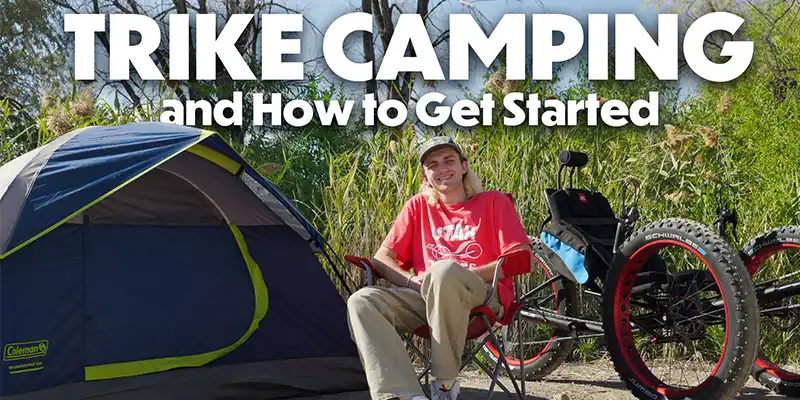
Trike Camping: Essential Tips and Tricks
Published on 10/24/2024
People buy recumbent trikes for a wide range of uses. Like Commuting, Exercise, Long distance touring, and some are even used for offroad riding.
When you are offroad riding you can find lots of ways to enjoy your trike. One of the most unique ways is through a little thing called Trike Packing, or trike camping.
A way to get out into nature on an awesome camping trip all revolving around your trike.
In today's article we will break down what trike camping is, and what you'll need to consider when preparing to go on your own trike camping trip. Let's get right into it!
Trike Camping
Trike camping is a really unique form of camping. It's similar to backpacking in the way that you are sticking to a relatively limited storage capacity, while keeping a low profile. Most people use this method as a way of stealth camping, or what is called Trike Packing.
If you are interested in getting into Trike packing there are a lot of things you need to consider before you can hit the trails. Like what trike you will be using, Some important things to be taking, and accessories that will make your trip easier. So what can you do to prepare yourself?
First off let's talk about some of the basic gear you should have in mind as you are thinking about your trip.
Gear For Trike Camping
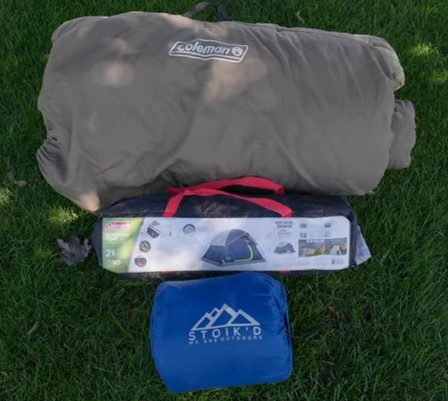
You are always going to need a place to sleep. So bedding is one of the first things to pack, and also one of the largest parts of your equipment arsenal. Always make sure you have some sort of shelter like a tent, a compact sleeping pad, and a sleeping bag to keep yourself warm.
To stay energized on your journey Food and water is a must. Depending on what you are planning to bring, you may need an insulated carrying bag to keep your food hot or cold. As Well as easily accessible snacks or other things you can use to refill as you are riding.
As you are planning what bags you will need and what you will be taking, it's also important to plan out where you can store these things that you will need easy access to without stopping your whole ride.
Other things you will need are some backpacking essentials.like stoves or cookware, clothing for weather you may face on your trip, First aid equipment, navigation, waterproofing gear, and anything else you may need for a smooth camping trip.
With all of this equipment you may be wondering how you can fit all of this stuff you need on a trike. Well there's only one solution and that's trike cargo bags.
Cargo bags come in plenty of different shapes and sizes for different amount of cargo that you will be carrying. But before you can start adding bags you are going to need to get a way to mount these bags first with a rear rack.
Depending on the type of trike you have there are plenty of rear racks you can install. For many trikes we have our UTCustom adjustable rear rack. It's a simple rack that fits perfectly on Catrikes, and Sunseekers.
For other brands like ICE and Azub they have their own rear rack system that is more modular. There are different sections of racks for maximum storage and specific kinds of bags. There are pannier mounting racks that sit under the seat more, and then add ons to add a top rack for even more storage space.
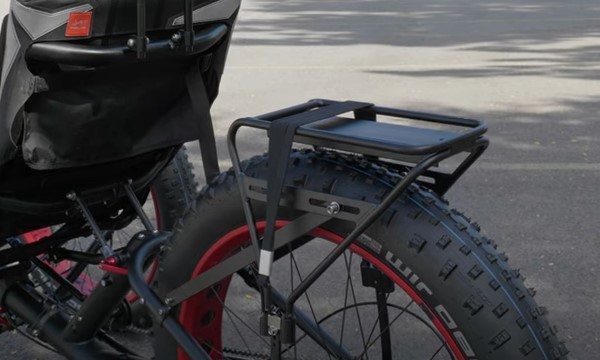
And that's the great thing about Trike packing over backpacking is that you have some more space to carry items, and the weight of your equipment isn't going directly on your back. You just have to be able to propel you and your equipment, which is arguably a bit easier.
The first bags to mention are Pannier bags. These are the bags that have the most storage space, and versatility. Panniers hang off the sides of your rear rack. Some clip to the sides, and others straddle the rack with some straps. But no matter how it mounts, these will give you the most storage space while still leaving the top of your rack open for any larger items you may need to strap down.
There are plenty of Pannier options depending on your needs. We have plenty of options from Axiom that range in size and style, and we carry our own Revolution panniers, which are water resistant and have a ton of space inside to fit the most gear possible.
Once you've installed your Panniers, either on the side of your main rack or with a pannier rack like you can find on ICE or Azub trikes. You'll have some room on the top of the rack. You can fill this with plenty of things. If you have a specific way you'd like to carry your supplies you can mount your own container with bungee cords or zip ties. If you need your own backpack for hiking while dismounted it's also a great spot to strap down another bag.
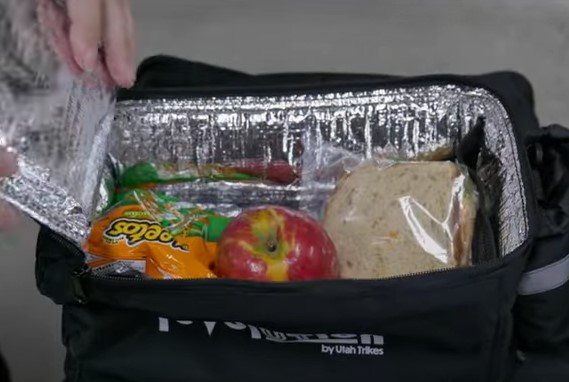
If you want a more secure option that will blend seamlessly with a pannier bag setup, we would recommend a trunk bag. There are also tons of options for trunk bags. With many models from Axiom, some hard shell options from Racktime, and our very own revolution insulated bag. These are great options, but all things considered they are better for shorter rides or tours where you just need to keep a couple food items cold, and carry a couple tools and things.
For a lot of trike packers out there a lot of them use waterproof duffels or other protective bags strapped to the top of their rack which gives better protection for your items, has more space, and is a little more applicable to a camping setting.
The top of the rack is a great place to stack and hold down your larger items, like a tent, sleeping bag, sleeping pad. Anything of the sort that is a bit longer or wider than your pannier bag.
Those options are more suited for the bulk packing aspect. They are behind you as you ride. If you have something back there you want to get to, you will find that they aren't the easiest to reach as you are riding.
For items you would like to be accessible from your seat, the best option would be a side bar bag, or saddle bags. A side bar bag is a little capsule bag attached to an additional bar that wraps around to the side of your trike. This is a great spot for a phone, water, a camera, anything decently sized that you want more protected.
An amazing option we recommend is the Ortlieb brand bar bag. It is a waterproof hardshell case that will keep all of your belongings safe. Not to mention it has a clear plastic top pocket that is perfect for a phone if you need to keep an eye on your GPS.
And secondly you can go for saddlebags. These are the most convenient style of bags you can get on a trike. There are different types for certain brands, but for an all size fits all saddle bag like this, all you have to do is throw it over the back of the seat and attach the loops to the top of the seat frame, and now you have two convenient bags hanging off the side of your seat. This spot is great for tools, food, extra water, a jacket, and anything you want to have on hand at a moment's notice.
Trikes for Trike Camping
Now that we’ve talked about the bags, what trikes are these bags even going on? The most common option for a purpose like this is gonna be a fat tire trike. When tackling off road terrains you want traction, and stability. A trike with wide knobby tires is going to give you the best platform to take on your adventure. And they often come with a higher weight capacity, which is great when you're carrying so much gear.
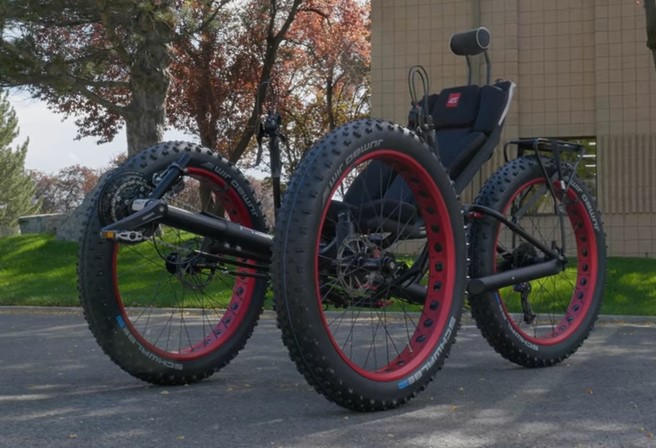
The trike I chose for today is one of the best fat tire trikes around. The AZUB Fatty 26. This trike is great for this type of ride because of its large 26 by 4 inch tires, comfortable build, and high weight capacity of 275 pounds. It has a tall ground clearance of 8.3 inches which is important to keep in mind when choosing your trike.
Another reason why fat tire trikes are great for trike packing is because of their built in suspension. A lot of them have frame suspension, like the ICE Full Fat or the Fat Tad CXS, but there's more to it than frame suspension alone.
If you know about the Fatty 26 already, you'll know that it's a fully rigid frame. But that doesn't stop it from having great suspension. When you have a trike with such tall and wide tires, they provide a natural soft suspension with more shock absorbing tires, and higher flexibility with the spokes. So with 26 by 4 inch tires the Azub Fatty has great suspension despite none on the frame.
Another great option for trike packing is a recumbent quad. These have a wider wheel base than a trike giving you more weight capacity, stability, and storage space in the rear. Something like the Revolution eQuad is great because it's outfitted with four 20 by 4 inch tires for great traction, and weight being dispersed across these 4 wheels gives you a weight capacity of about 300 pounds, and a towing capacity of 100 pounds. And that's not to mention the eQuad XL frame that bumps up the capacity to 400 pounds.
On a quad like this as you can see there's a big empty space here in the back. You can throw a rear rack on here and get a 23 inch wide rack space. That is massive compared to a trike rack's standard 6 inch width.
It doesn't allow for panniers, but you can fit a lot more on the top of this rack and can be a simpler solution than getting all of these bag options for a trike.
And for even more storage space, small trailers can be hooked up to the back of the eQuad to tow up to 100 pounds of extra equipment.
Besides fat tire, and quad options, let's be real. You can take any trike to do trike packing. I've seen a guy on youtube go out with a fully loaded Catrike 700 on nothing but road tires hit some crazy rocky trails doing this stuff. Granted it didn't look like the most comfortable ride, but it works.
As long as you know what your terrain will look like, and have the tools needed to keep your trike running on these rough rides then you can make anything work.
Gearing for Trike Camping
Now that being said. What if the rides you want to do have steep inclines, and difficult climbing terrain? Well then you want to make sure you're prepared with your gearing, and of course your physical ability. If you are confident in your strength to take you up terrain like this the next step is to consider your gearing.
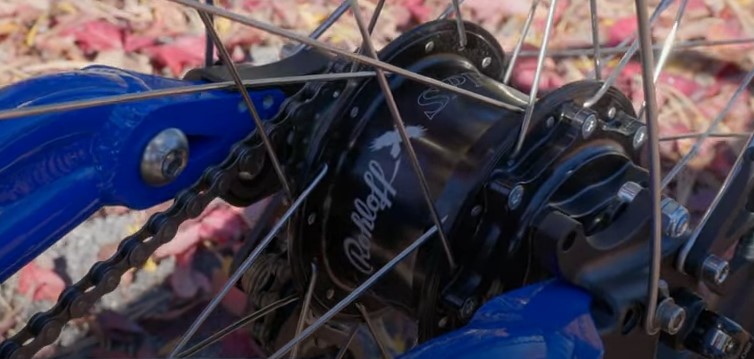
To compensate for varied riding conditions and higher carried weight you may want to upgrade your gearing to something with a higher gear range. We always recommend an internally geared hub like the Rohloff. Which provides 14 speed rear gearing as well as an internally geared hub so your gearing stays protected, and you won't have to worry about water damage, or any other difficulties that may arise from dirty gearing in an environment like this.
You can always opt for a motor as well. It can be nice to have an extra boost of power for rough terrains, especially when you are carrying so much weight. Something to consider with a motor is the extra weight that will add to your already heft cargo. A motor itself adds about 15 pounds to your trike, and then each battery is about 10. So depending on how many batteries you are using that can add up really fast.
It's also worth considering your battery power. If you are relying heavily on a motor and have no way to charge the batteries, chances are your batteries will die before you get to head back home, and now you've just got 25 pounds of extra weight to haul back.
A motor can be a good option for a lot of folks, but it's important to keep in mind how it may fare in a more nature oriented setting. The best course of action is to plan how long you will ride, the weather conditions, and the terrain. Then take action to conserve your motor's battery by staying in low assist mode, or just turning it off until you need it for a steep hill.
With so many trikes and configuration options, you can really take up any type of trike packing that you would like. And with whatever trike setup you end up going with, there are always accessories you can add to your trike camping trips even better.
Besides racks and bags there are some small things that can really elevate your trike packing experience, and are arguably pretty necessary.
Lights for Trike Camping
A big one to consider is lighting. All things considered you are probably going to be triking in the dark at some point if you plan to be spending the night with your trike. Having a bright headlight for visibility is a big deal. The last thing you want to do is to be pedaling through the woods or the rocky terrain of the desert with no way to see where you are going.
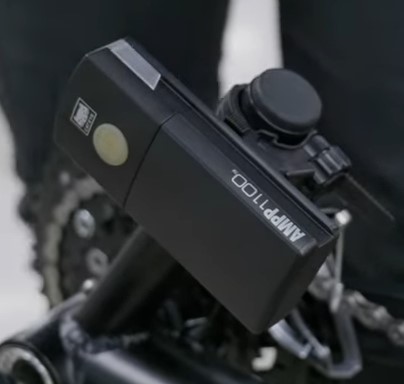
A great option are the headlights you can attach separately to your trike. Like the Cat Eye AMPP1100. This is a bright light and also can attach to any free bar on your trike for easy mounting. It's also great because you can take it off of your trike super easily, so if you need a really bright handheld flashlight, outside of when you are riding. This will be a verstitle option.
Headlights like this are battery operated and need to be recharged, so if you are planning to go with a headlight like this make sure to bring a battery pack so you can stay fully charged wherever you are, and not risk being left in the dark.
Anothing important accessory would be a bike lock. You may only think about having a bike lock in an urban setting, but I would argue its good to have anywhere, even if you are in the middle of nowhere.
Camping requires you to leave your trike outside of your tent, or even alone at your campsite depending where you are going. It's always worth it to have some way to lock up your trike, just in case someone comes by and finds an easy trike target.
Get Out and Ride!
And those are the main accessories you might have forgotten to include in your trike packing list. There's many more you can get for comfort and preference though. Like water bottle holders, upgraded seat padding, different pedals, you name it.
As you can tell, what you need for trike packing is a bit involved. But very necessary, the last thing you want to do is head out for a long trip like this unprepared. So let's go over your trike packing checklist just to make sure we got it all.
First off is the base - You need a trike or quad fit for your riding terrain, preferably something with fat tires for off road packing. While making sure to consider your gearing and having the right fit for your riding conditions
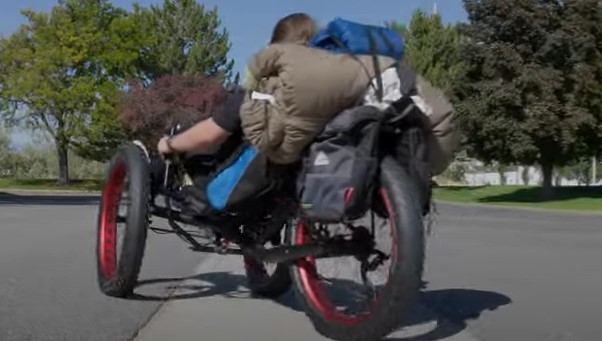
Second - A way to carry your supplies - So all of your bags and mounting racks
Third - Trike camping equipment. What I talked about earlier is just the basics, there's a lot more you can find online. Its mainly the standard essentials of any regular backpacking trip so finding a guide online, or fellow trike packers is always a great idea to make sure you're not missing anything.
And lastly - With your equipment one of the most important things is first aid, for you.. And your trike. Make sure you have a good first aid kid to handle any accidents that may occur while camping, and a good tool kit to fix up your trike if need be. You never know when you'll pop a tire and the last thing you want is to be stranded out in the middle of nowhere with a flat.
Once you have all these planned out, you should be ready to get out and start trike packing. This is a really cool sub culture of the trike community and a really fun activity to go do with your trike. So as long as you are prepared it's going to be a great time, with some new friends waiting for you along the way!




